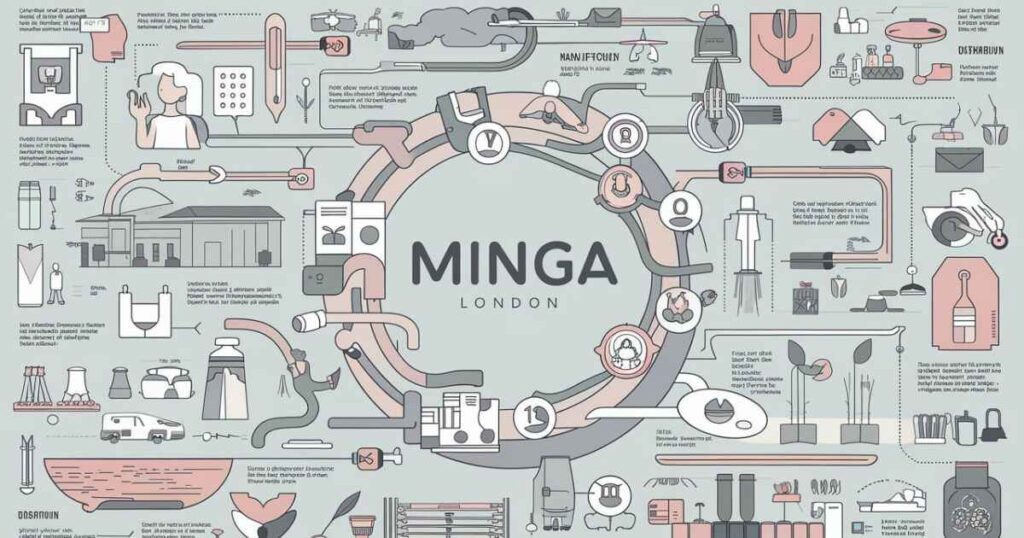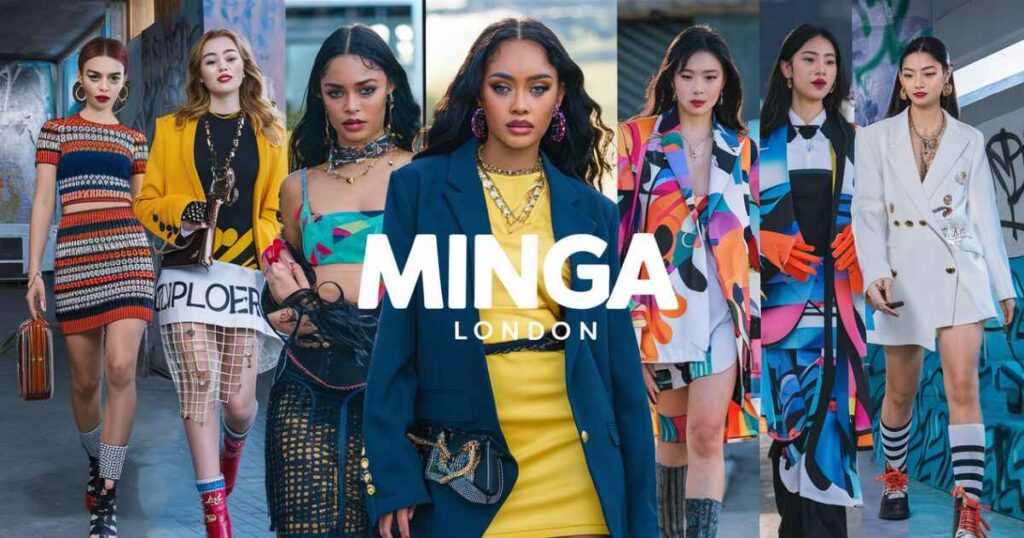In today’s rapidly evolving fashion landscape, consumers are increasingly questioning the ethics and sustainability of their favorite brands. One name that’s been catching attention is Minga London.
But the burning question remains: Is Minga London fast fashion? This comprehensive analysis will delve into the heart of Minga London’s operations, comparing them to established fast fashion criteria, and examining their impact on the industry and environment.
Introduction to Fast Fashion
Fast fashion has revolutionized the way we consume clothing, for better or worse. This phenomenon refers to inexpensive, trendy garments that move quickly from design to retail stores to meet consumer demand for the latest styles. Born in the late 1990s and early 2000s, fast fashion has become a dominating force in the industry, characterized by:
- Rapid production cycles
- Low-cost manufacturing
- High-volume sales
- Frequent collection releases
The digital age has supercharged fast fashion’s growth. E-commerce platforms allow brands to reach global audiences instantly, while social media accelerates trend cycles at breakneck speeds. Instagram and TikTok have become virtual runways, with styles going viral and sparking immediate demand.
The Rise of Fast Fashion in the Digital Age
The advent of social media has played a pivotal role in the fast fashion boom. Platforms like Instagram, Pinterest, and TikTok have created an insatiable appetite for new styles, with influencers and celebrities showcasing new looks daily. This constant stream of fashion content has led to:
- Shortened trend cycles
- Increased pressure on brands to produce new styles quickly
- A culture of “outfit of the day” posts, encouraging constant wardrobe refreshes
Fast fashion brands have capitalized on this by leveraging data analytics to spot emerging trends and quickly produce on-trend items. This rapid response to consumer desires has further fueled the fast fashion machine, creating a cycle of constant consumption.
Overview of Minga London
Founded in 2016, Minga London burst onto the scene as a UK-based fashion retailer targeting young, trend-conscious consumers. Their brand identity revolves around offering the latest styles at affordable prices, with a particular focus on party wear and statement pieces.
Minga London’s online presence is robust, with a user-friendly website and active social media accounts. Their marketing approach mirrors that of many fast fashion brands:
- Frequent posts showcasing new arrivals
- Collaborations with influencers and micro-influencers
- Flash sales and limited-time offers
Their product range spans from casual wear to glitzy party dresses, with prices generally falling in the low to mid-range bracket. This positioning aligns closely with the fast fashion model, but let’s dig deeper to see if Minga London truly fits the mold.
Minga London’s Online Presence and Marketing Approach
Minga London’s digital strategy is a testament to the power of social media in fashion marketing. Their Instagram account, boasting over 200,000 followers, serves as a dynamic lookbook, updated daily with new styles and outfit inspirations. This constant stream of content keeps their brand at the forefront of their target audience’s minds.
The brand’s marketing tactics include:
- User-generated content campaigns
- Hashtag challenges encouraging customers to share their Minga London looks
- Behind-the-scenes glimpses into photoshoots and the design process
- Limited-time discount codes to drive immediate sales
These strategies create a sense of urgency and exclusivity, hallmarks of fast fashion marketing. By keeping their audience engaged and always anticipating the next big thing, Minga London maintains a cycle of consistent interest and purchasing.
Characteristics of Fast Fashion Brands
To determine if Minga London is indeed fast fashion, we need to examine the key indicators of this business model:
- Rapid production cycles: Fast fashion brands typically go from design to retail in weeks, not months.
- Trend replication: Quick knockoffs of runway or celebrity-worn styles.
- Low-cost manufacturing: Often achieved through outsourcing to countries with lower labor costs.
- High-volume sales: Emphasis on selling large quantities at lower profit margins.
- Frequent collection releases: New styles hitting stores weekly or even daily.
Here’s a comparison table of typical fast fashion practices versus traditional retail:
| Aspect | Fast Fashion | Traditional Retail |
| Design to Store | 2-4 weeks | 3-6 months |
| Collections per Year | 52+ | 2-4 |
| Manufacturing Location | Primarily overseas | Mix of local and overseas |
| Price Point | Low to medium | Medium to high |
| Inventory Turnover | Very high | Moderate |
Fast Fashion Business Model Indicators
The fast fashion business model is built on a foundation of speed and efficiency. Key indicators include:
- Just-in-time production: Minimizing inventory by producing only what’s expected to sell quickly.
- Flexible supply chains: The ability to pivot quickly based on emerging trends.
- Data-driven decision making: Using real-time sales data to inform production decisions.
- Economies of scale: Leveraging large production volumes to negotiate lower costs.
These factors combine to create a model that can respond rapidly to consumer demands while maintaining profitability despite low price points.
Analyzing Minga London’s Production Cycle

Investigating Minga London’s supply chain reveals some telling information. While the company doesn’t publicly disclose its full production process, we can glean insights from their website and industry reports:
- New arrivals: Minga London adds new styles to their website multiple times a week, indicating a rapid production cycle.
- Trend alignment: Their offerings closely mirror current fashion trends, suggesting quick turnaround from design to production.
- Pricing strategy: The affordable price points hint at cost-cutting measures in manufacturing.
These factors align closely with fast fashion practices. However, it’s worth noting that Minga London’s production speed doesn’t appear to match the breakneck pace of giants like Zara or H&M, which can go from concept to store in as little as two weeks.
Production Speed vs. Quality Control
The balance between speed and quality is a constant challenge in fast fashion. Minga London, like many of its peers, must navigate this delicate equilibrium. Customer reviews provide some insight:
- Positive feedback often highlights the on-trend designs and affordable prices.
- Negative reviews sometimes mention issues with fabric quality or construction.
This mixed feedback suggests that while Minga London succeeds in delivering trendy styles quickly, there may be occasional compromises in quality control—a common trade-off in the fast fashion world.
Ethical and Environmental Implications
The fast fashion model has come under intense scrutiny for its ethical and environmental impact. Key concerns include:
- Labor practices: Exploitation of workers in low-wage countries
- Environmental damage: High water usage, textile waste, and carbon emissions
- Overconsumption: Encouraging a “wear once” mentality
Minga London, like many brands, faces these challenges. While they don’t prominently feature sustainability initiatives on their website, this doesn’t necessarily mean they’re not taking steps behind the scenes. However, the lack of transparency is noteworthy in an era where consumers increasingly demand accountability.
Read Also: Is Madewell Fast Fashion? Unraveling the Truth Behind the Brand
Minga London’s Stance on Ethical Production
As of our latest research, Minga London has not publicly detailed its ethical production practices or sustainability goals. This silence is increasingly unusual in the fashion industry, where many brands are making public commitments to improve their environmental and social impact.
The absence of information leaves several questions unanswered:
- What are the working conditions in Minga London’s supply chain?
- Does the company have any initiatives to reduce its environmental footprint?
- Are there plans to incorporate more sustainable materials into their products?
As consumer awareness grows, addressing these questions may become crucial for Minga London’s long-term success and reputation.
Minga London’s Position in the Market
In the crowded fast fashion market, Minga London has carved out a niche focusing on statement pieces and party wear. Their growth trajectory suggests they’ve found a receptive audience, but they remain a smaller player compared to fast fashion giants like ASOS or Boohoo.
Minga London’s unique selling proposition appears to be their bold, eye-catching designs at accessible price points. This strategy has helped build a loyal customer base, particularly among young consumers looking for standout pieces for social events and nights out.
Minga London’s Competitive Edge
Despite fierce competition, Minga London has managed to distinguish itself in several ways:
- Focus on statement pieces: While many fast fashion brands offer a wide range of basics and trends, Minga London leans into bold, attention-grabbing styles.
- Social media savvy: Their strong Instagram presence and influencer collaborations keep them relevant to their target demographic.
- Responsive customer service: Many reviews praise the brand’s attentiveness to customer queries and issues.
- Niche targeting: By focusing on party wear and going-out looks, they’ve found a specific market segment to dominate.
These factors have allowed Minga London to maintain a loyal customer base in a highly competitive industry.
Comparing Minga London to Other Fast Fashion Brands
When we stack Minga London against established fast fashion retailers, we see both similarities and differences:
- Product lifecycle: While quick, it doesn’t match the ultra-fast turnaround of some competitors.
- Price point: Comparable to other fast fashion brands, sometimes slightly higher for statement pieces.
- Target demographic: Aligned with the typical fast fashion focus on young, trend-conscious consumers.
- Sustainability communication: Less prominent than some competitors who have launched eco-friendly lines.
Case Studies: Minga London vs. Traditional Fast Fashion
Let’s compare Minga London to a fast fashion giant like Zara:
- Production speed: Zara can go from design to store in 2 weeks; Minga London appears to operate on a slightly longer timeline.
- Store presence: Zara has a vast network of physical stores; Minga London is primarily online.
- Product range: Zara offers a wide range from basics to formal wear; Minga London focuses more on statement and party pieces.
- Pricing: Minga London’s prices are generally lower than Zara’s, especially for trend-driven items.
This comparison reveals that while Minga London operates within the fast fashion model, they’ve adapted it to suit their specific niche and scale.
Customer Perception of Minga London
A deep dive into customer reviews and social media sentiment reveals mixed opinions:
- Positive feedback: Often centered on unique designs and affordability.
- Criticism: Sometimes focuses on quality issues or sizing inconsistencies.
- Brand image: Generally perceived as trendy and youth-oriented.
The Minga London shopping experience seems to prioritize trendiness and affordability, hallmarks of the fast fashion model. However, customer service responsiveness appears to be a point of differentiation, with many reviewers praising the company’s attentiveness to queries and issues.
The Minga London Shopping Experience
The online shopping experience at Minga London is designed to encourage frequent purchases:
- Regular updates to the website’s “New In” section
- Prominent display of sale items and discounts
- Easy-to-navigate categories based on clothing type and occasion
- Size guides and styling suggestions to aid purchase decisions
These features, combined with their active social media presence, create an environment that encourages regular browsing and purchasing—a key aspect of the fast fashion business model.
Minga London’s Response to Fast Fashion Criticism
As of my last update, Minga London hasn’t made high-profile public statements addressing fast fashion concerns. Their website doesn’t prominently feature sustainability initiatives or ethical production commitments. This lack of communication on these issues is notable, especially as many consumers now expect brands to take a stand on environmental and ethical concerns.
Future Plans and Commitments
Without clear public statements, it’s challenging to gauge Minga London’s future direction regarding sustainability and ethical practices. However, industry trends suggest that addressing these concerns may become unavoidable:
- Increasing consumer demand for transparency
- Potential future regulations on fashion industry practices
- Growing competition from sustainable and slow fashion brands
How Minga London chooses to respond to these pressures could significantly impact their future in the market.
The Future of Minga London in a Changing Fashion Landscape
The fashion industry is at a crossroads, with increasing pressure to address environmental and ethical concerns. For Minga London, this presents both challenges and opportunities:
- Sustainability initiatives: Implementing and communicating sustainable practices could appeal to eco-conscious consumers.
- Transparency: Providing more information about their supply chain could build trust with their customer base.
- Quality focus: Emphasizing durability could help combat the “disposable fashion” stigma associated with fast fashion.
- Circular fashion: Exploring rental or resale models could align with changing consumer preferences.
How Minga London navigates these industry shifts will likely determine their long-term success and reputation in the fashion world.
In the ever-evolving world of fashion, staying informed about brand practices is crucial for making conscious purchasing decisions. Whether Minga London is fast fashion or not, the power ultimately lies with the consumer to choose where and how they shop. As we continue to grapple with the environmental and ethical implications of our clothing choices, brands like Minga London will need to adapt to meet the changing demands of an increasingly aware consumer base.
Conclusion: Is Minga London Truly Fast Fashion?
After thorough analysis, it’s clear that Minga London does align with many fast fashion practices. Their rapid product cycles, trend-driven designs, and affordable pricing fit the fast fashion model. However, they operate on a smaller scale than industry giants, potentially allowing for more agility in their practices.
As consumer awareness grows, Minga London faces a pivotal moment. Their future success may hinge on how they address sustainability and ethical concerns. Whether they choose to innovate towards more responsible practices or maintain their current model will be crucial.
Ultimately, the power lies with consumers. By staying informed and making conscious choices, shoppers can influence the direction of brands like Minga London and the fashion industry as a whole.

Ella Marie is a dedicated fashion enthusiast committed to curating the latest trends and timeless styles. With a keen eye for detail and a passion for elegance, they ensure every visitor finds inspiration and sophistication on the site.








